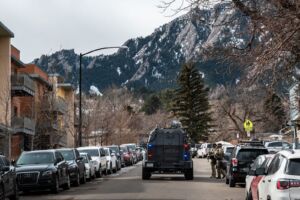Computer, textbook, pencil case and armor plates
Understanding mass casualty events, why they happen and what can be done about them.
By Sasha Novack
Jansport, Fjallraven and Herschel were the most popular backpacks at my high school. Jansport was the standard, having the largest carrying capacity for books and supplies. Fjallraven was artsy and stylish, albeit a little more impractical due to its fewer pockets. Herschel was the hipster choice for those who dressed in button-downs and slacks.
I, of course, had a hand-me-down Eddie Bauer bag with only one functional strap and a carabiner clip attached to a water bottle that would hit the backs of my legs as I walked.
While all three of these brands are still trendy, two other styles have risen in popularity in recent years: the transparent backpack and the bullet-proof backpack. Both of these backpacks were inspired by the ever growing fear of mass shootings.
Mass shootings are not an easy issue to digest; acts of violence of this magnitude are hard to comprehend. But for Arvada, Aurora, Boulder, Colorado Springs, Columbine, Denver, Littleton, and many other Colorado towns, it is the reality we face. The Denver metro area has the third highest rate of mass shootings per capita in the country.
Why do these mass shootings happen, and what can we do to prevent them? Some say access to mental health care is the answer, while others say it is gun control laws, and others still say it is school safety and school safety officers. All of these categories have been addressed and improved one way or another, but 2nd amendment rights are still the most hotly debated out of all of them.
Bill Woodward, the Director of Training and Technical Assistance at the University of Colorado Boulder’s Center for the Study and Prevention of Violence, has proposed a comprehensive list of things a community can address to reduce the chances of school shootings, specifically, which he calls the “Five Major Investments.” These action items can be generalized to mass shootings.

Climate and culture of community
The first major investment strives to change how various communities view “outsiders” and respond to bullying.
In a school environment, bullying is an inevitability. The millions of dollars put into the development of bullying prevention programs has reduced bullying in the U.S. by 11% over the past 30 years, according to some estimates. Other studies argue these bullying prevention programs only make the problem worse.
In 1999, The Columbine school shooting set a precedent for the societal stereotype of a school shooter. According to the FBI, this stereotype of school shooters being “goth,” “emo” or “loners’” is wrong. But the feeling of loneliness caused by being singled out by a bully—and its compounding nature with depression and suicidal thoughts—can create violent tendencies.
According to Woodward, “When a student feels like they can’t speak up and get support, they feel as if they have no other option.”
When teachers and parents do not listen to students when they talk about encounters with bullies, do not believe them or attempt to resolve the situation, or when students think reporting a bullying incident is futile and will yield no results, students are left with little hope and a lot of anger. This anger, when coupled with access to firearms and a litany of other circumstances, can lead to a school shooting.
The sense of isolation experienced by high schoolers is reportedly common among perpetrators after they graduate from the education system. A loss of support systems and lack of vision for the future coupled with a perceived grievance like a job termination may put one down a path to prison.
Mental and behavioral health
The second major investment deals with our perception and treatment of mental and behavioral health issues.
There is contention on whether mass shootings are related to mental health, but according to researchers at the University of Alabama, Vanderbilt University and many other institutions, mental health plays a major role in mass shootings.
Studies have found that, while mental health is not the end-all be-all cause of mass shootings, up to 78% of perpetrators between 1982 and 2019 had an untreated mental illness. In the case of the King Soopers shooting, the perpetrator was deemed unfit to stand trial due to his mental health issues.
Would access to free mental health care stop all these perpetrators? Most likely not. But recent legislation has been drastically improving both the volume and quality of care given to those in poor mental health. The creation of a neuropsychology facility for people younger than 21, proper training in pediatric behavioral health for counselors and schools, and outreach to parents are just a few of the recent steps lawmakers are taking, all of which have the promise to prevent future tragedies from occuring.
Especially with the younger demographic, the burden of responsibility for finding mental health care often falls on parents. If parents either do not see the signs of mental illness in their child or choose to ignore them, they have missed a vital step in supporting their child, and a potentially preventable act of mass violence was the consequence. The Department of Justice has even prosecuted parents for involuntary manslaughter if the situation was clearly preventable.
Threat assessment
The third major investment addresses how violent threats should be handled by schools and law enforcement agencies.
Nowadays, it is a frequent occurrence for high schools and college campuses to go into lockdown when a student makes a threatening TikTok post, but how do institutions and the police determine just how serious such a post was? After all, students do not always understand the severity of their online actions and may very well say something online under the veil of anonymity that they don’t truly mean.
One of the main factors that law enforcement looks at when responding to a shooting threat is access to weapons. Woodward said that if a student “makes a threat and there are weapons at home, a home visit is required.” If an adult in question has tried—successfully or unsuccessfully—to purchase a weapon in the past, their threat is met with a visit from a special weapons and tactics police team.
If the student or adult does not have access to a weapon or armaments, they will most likely still be arrested and questioned, but the response is less likely to cause a major disruption to school or work communities. Abraham Maslow, a renowned American psychologist, is quoted in the FBI’s threat assessment document saying “If the only tool you have is a hammer, you tend to see every problem as a nail.” Every threat is taken seriously in today’s day and age, but each threat’s severity gets matched by an appropriate police response.
Bystander response and reporting
The fourth major investment invites friends, family, teachers and coworkers to speak up about things they hear or see.
In pop culture nowadays, there is an ongoing joke about taking a “grippy sock vacation.” Such a vacation is when someone is (often involuntarily) hospitalized for violent or suicidal thoughts or tendencies. Oftentimes, people are afraid of oversharing with their therapists or guidance counselors for fear of going on a grippy sock vacation, but they will sometimes share their struggles with their closest friends.
Despite the “loner” stereotype assigned to many perpetrators, they are almost never truly alone. Whether through family, through teachers, or through peers, almost all perpetrators still have a connection to the outside world, a person who can view their evolving struggles with mental health.
If a friend or family member shares potentially harmful ideologies or struggles with their mental health, it is vital that the person they share this information with seek aid from professionals. According to Woodward, “families have not been sensitized to this idea that they can actually easily get help for handling someone in their family who is mentally ill.”
Such a mindset requires a minor shift in societal values and that we emphasize it is okay to not be okay. There is nothing wrong with you or a family member seeking treatment for mental health. Calling the police to knock on your friend’s door, also known as a wellness check, is not the only option, and just giving your loved one the opportunity to talk to a professional may save them and others.
Many areas in Colorado have also implemented a “Text-A-Tip” program, where anyone can anonymously submit a tip to the police without needing to call. This program helped stop a school shooting in 2015 at the Mountain Vista High School in Highland Ranch.
Information sharing
The final major investment highlights the importance of interagency communication.
Here at CU Boulder, we witnessed firsthand the efficacy and speed of information sharing between agencies in February, when police responded to a wanted person of interest on the University Hill.
This person of interest had published a manifesto at the University of California Los Angeles campus, where campus police pursued him, and he subsequently fled to Boulder. UCLA campus police promptly shared their information with the CU Boulder Police force and the Boulder Police Department.
In a school, information sharing becomes a little hazier than between government agencies. Woodward said, “Some guidance counselors’ high schools do not share any information to law enforcement or parents because they fear they will violate HIPAA laws. This should not be the case, since according to the Attorney General Decree 18-01, HIPAA does not apply in schools since schools are not actually doing treatment.”
Since HIPAA laws are not applicable in schools, counselors are allowed to share information about potentially violent thoughts students may have with their parents or police. This sharing may give the police vital information to diffuse a situation, or provide parents the means to prevent a violent outburst in the first place.
Woodward also expressed the importance of other adults sharing information with police and parents, such as teachers and bus drivers.
“Bus drivers see the bad behavior before most teachers do. They should be reporting it to the school,” said Woodward. “Sometimes, they don’t have the avenues to report it properly to the school.”
Even if all these steps are taken and changes are implemented, even if gun control laws are passed and family resource centers open for mental health care, there will still be mass shootings. Perhaps a bullet-proof backpack or suitcase will become standard school and workplace attire. But if even some of the ideas and changes introduced by Woodward are implemented, we may feel a little bit safer at the grocery store or movie theater.

